Research Proposal: Investigating Reverse Logistics Issues in Portugal
VerifiedAdded on 2022/11/26
|10
|1455
|479
Report
AI Summary
This research proposal investigates the issues of reverse logistics commonly practiced in Portuguese commercial establishments. The study encompasses various segments, including a discussion of data collection procedures and data analysis techniques. The proposal outlines the research philosophy, approach, and design, specifying the use of an explanatory research design with both primary and secondary data collection methods. Primary data will be gathered through interviews, and secondary data will be sourced from peer-reviewed articles. The research employs both qualitative data analysis methods and a combination of probabilistic and non-probabilistic sampling. Ethical considerations, such as maintaining data privacy and providing proper referencing, are addressed, along with the limitations of the study, particularly financial constraints. The proposal aims to identify the benefits, limitations, and areas for improvement in reverse logistics practices within the context of Portuguese businesses.
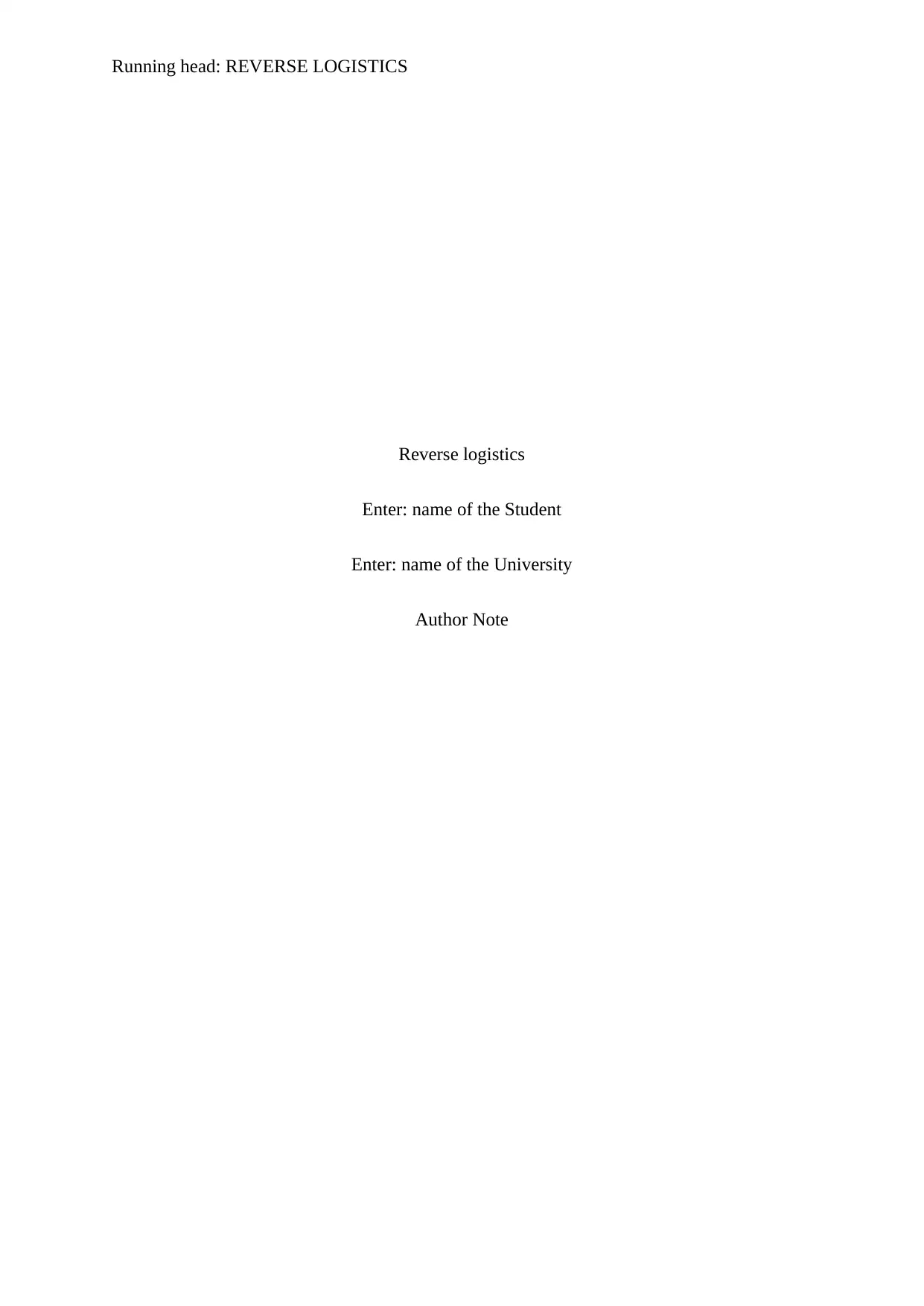
Running head: REVERSE LOGISTICS
Reverse logistics
Enter: name of the Student
Enter: name of the University
Author Note
Reverse logistics
Enter: name of the Student
Enter: name of the University
Author Note
Paraphrase This Document
Need a fresh take? Get an instant paraphrase of this document with our AI Paraphraser
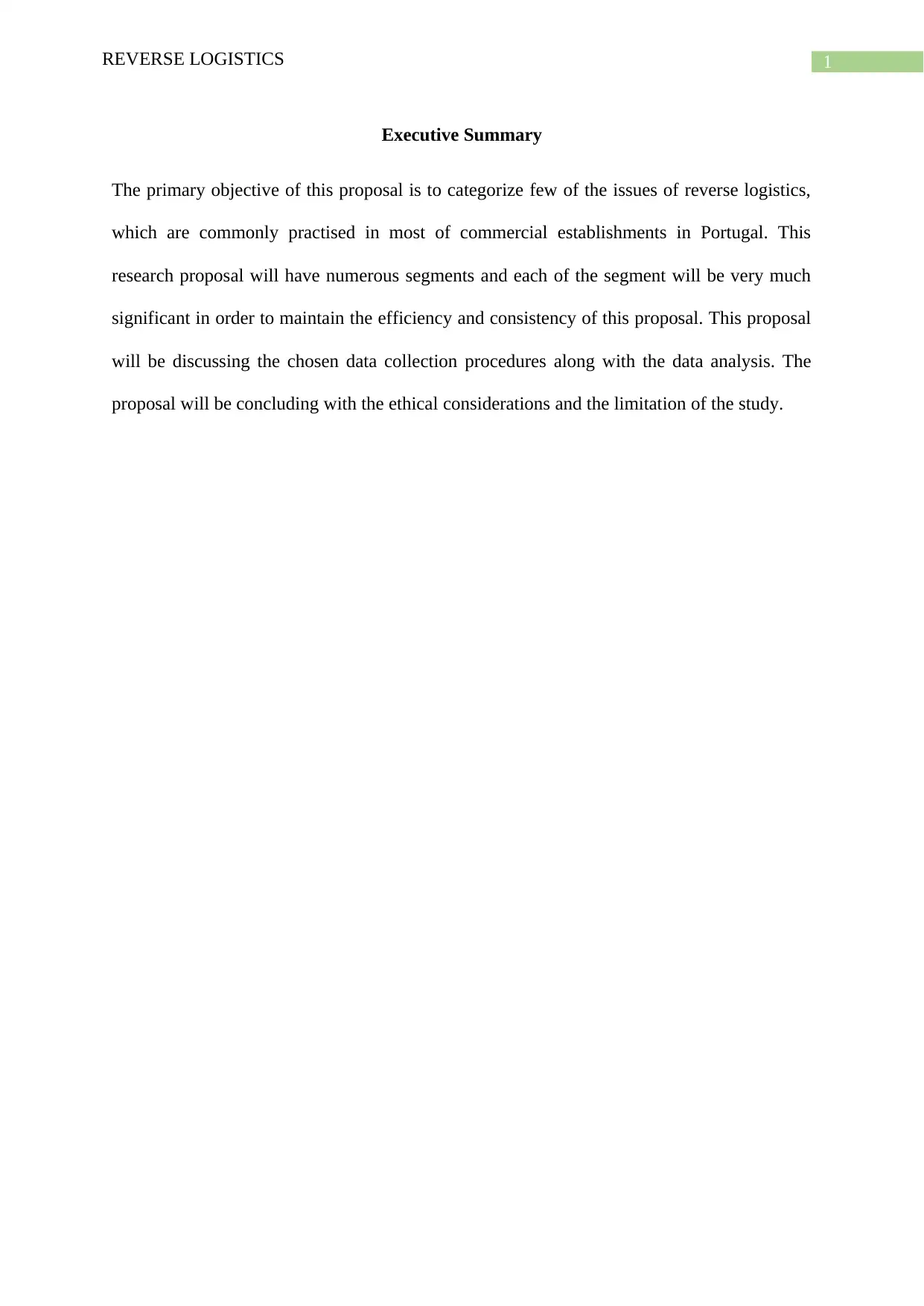
1REVERSE LOGISTICS
Executive Summary
The primary objective of this proposal is to categorize few of the issues of reverse logistics,
which are commonly practised in most of commercial establishments in Portugal. This
research proposal will have numerous segments and each of the segment will be very much
significant in order to maintain the efficiency and consistency of this proposal. This proposal
will be discussing the chosen data collection procedures along with the data analysis. The
proposal will be concluding with the ethical considerations and the limitation of the study.
Executive Summary
The primary objective of this proposal is to categorize few of the issues of reverse logistics,
which are commonly practised in most of commercial establishments in Portugal. This
research proposal will have numerous segments and each of the segment will be very much
significant in order to maintain the efficiency and consistency of this proposal. This proposal
will be discussing the chosen data collection procedures along with the data analysis. The
proposal will be concluding with the ethical considerations and the limitation of the study.
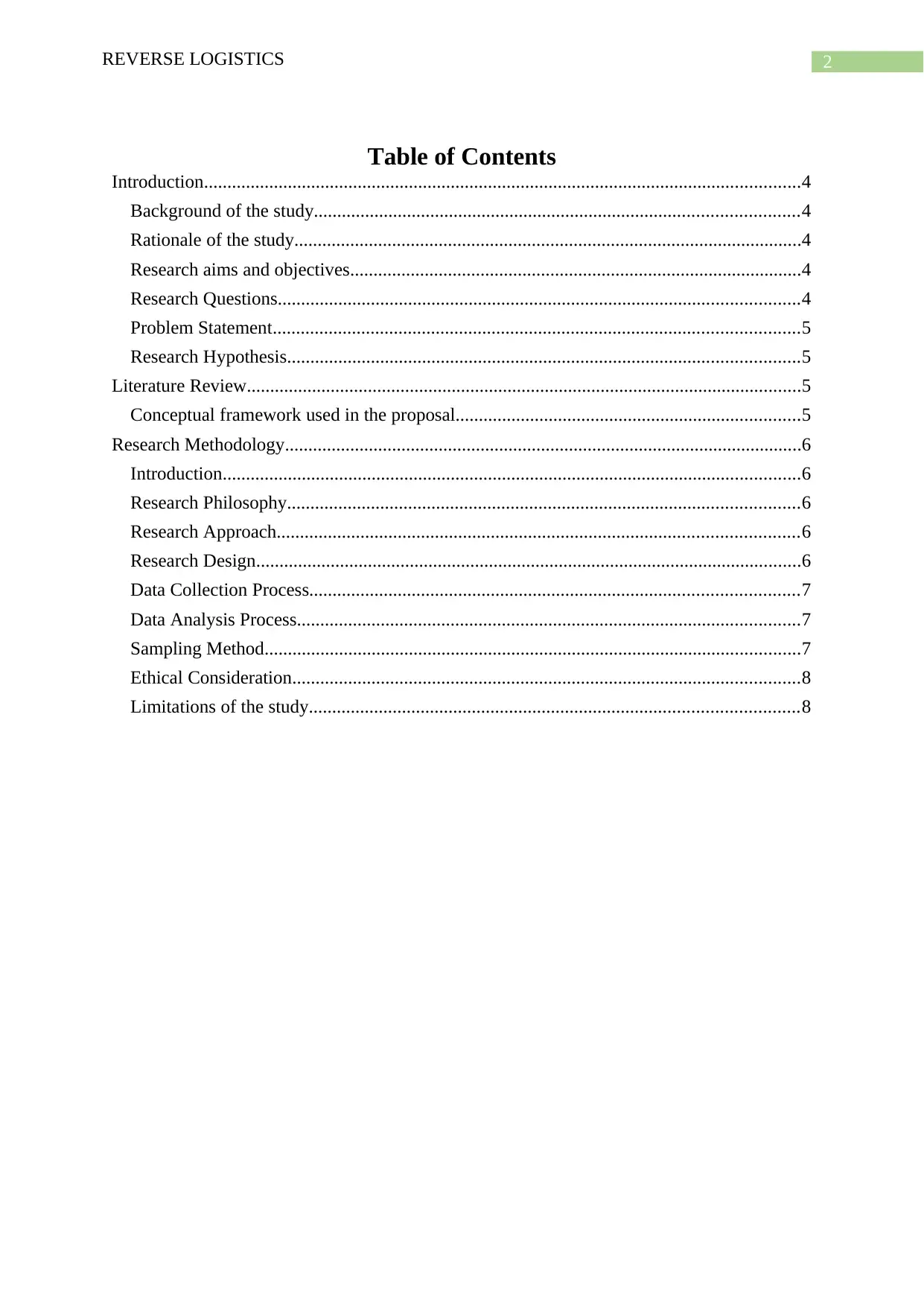
2REVERSE LOGISTICS
Table of Contents
Introduction................................................................................................................................4
Background of the study........................................................................................................4
Rationale of the study.............................................................................................................4
Research aims and objectives.................................................................................................4
Research Questions................................................................................................................4
Problem Statement.................................................................................................................5
Research Hypothesis..............................................................................................................5
Literature Review.......................................................................................................................5
Conceptual framework used in the proposal..........................................................................5
Research Methodology...............................................................................................................6
Introduction............................................................................................................................6
Research Philosophy..............................................................................................................6
Research Approach................................................................................................................6
Research Design.....................................................................................................................6
Data Collection Process.........................................................................................................7
Data Analysis Process............................................................................................................7
Sampling Method...................................................................................................................7
Ethical Consideration.............................................................................................................8
Limitations of the study.........................................................................................................8
Table of Contents
Introduction................................................................................................................................4
Background of the study........................................................................................................4
Rationale of the study.............................................................................................................4
Research aims and objectives.................................................................................................4
Research Questions................................................................................................................4
Problem Statement.................................................................................................................5
Research Hypothesis..............................................................................................................5
Literature Review.......................................................................................................................5
Conceptual framework used in the proposal..........................................................................5
Research Methodology...............................................................................................................6
Introduction............................................................................................................................6
Research Philosophy..............................................................................................................6
Research Approach................................................................................................................6
Research Design.....................................................................................................................6
Data Collection Process.........................................................................................................7
Data Analysis Process............................................................................................................7
Sampling Method...................................................................................................................7
Ethical Consideration.............................................................................................................8
Limitations of the study.........................................................................................................8
⊘ This is a preview!⊘
Do you want full access?
Subscribe today to unlock all pages.

Trusted by 1+ million students worldwide
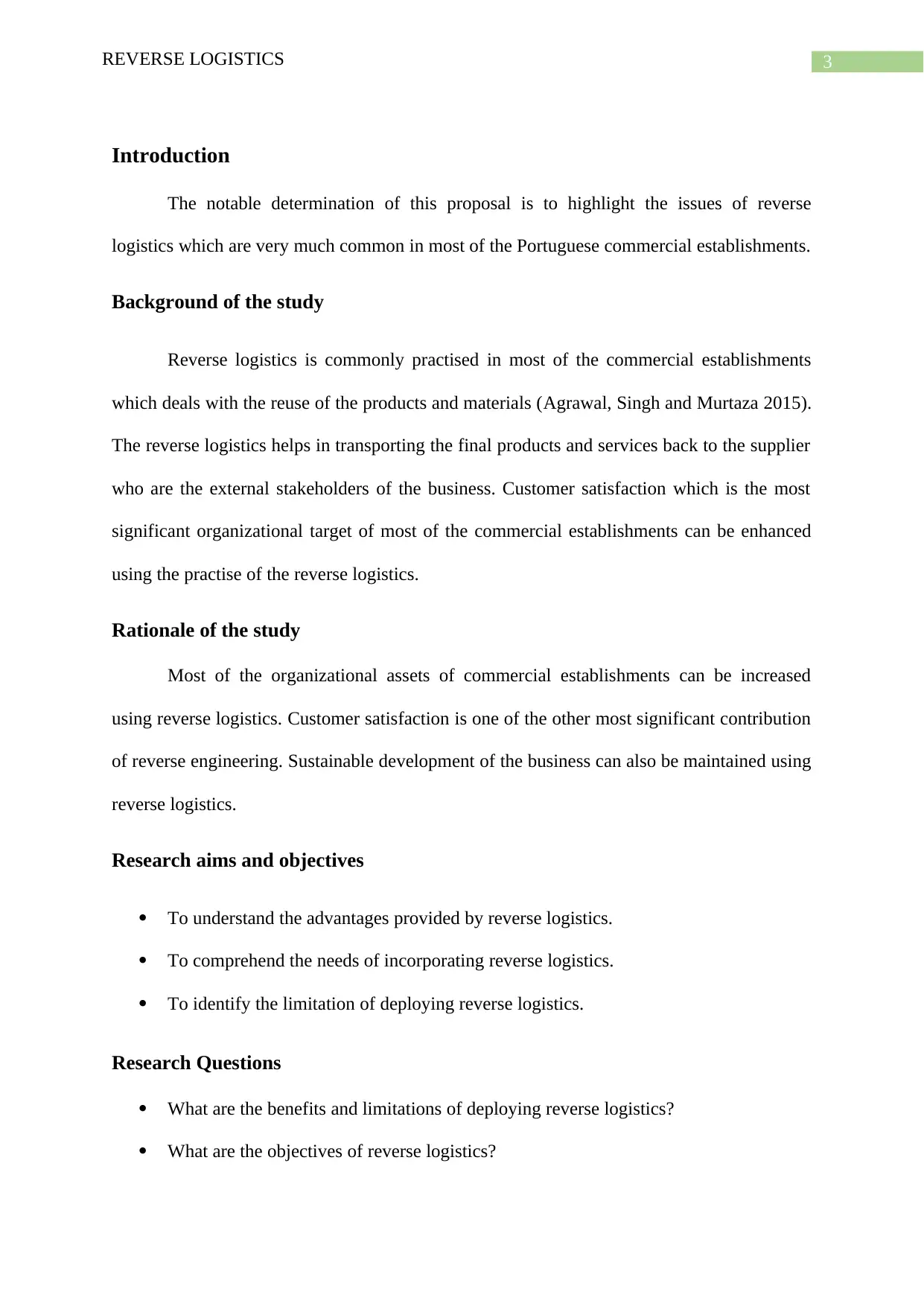
3REVERSE LOGISTICS
Introduction
The notable determination of this proposal is to highlight the issues of reverse
logistics which are very much common in most of the Portuguese commercial establishments.
Background of the study
Reverse logistics is commonly practised in most of the commercial establishments
which deals with the reuse of the products and materials (Agrawal, Singh and Murtaza 2015).
The reverse logistics helps in transporting the final products and services back to the supplier
who are the external stakeholders of the business. Customer satisfaction which is the most
significant organizational target of most of the commercial establishments can be enhanced
using the practise of the reverse logistics.
Rationale of the study
Most of the organizational assets of commercial establishments can be increased
using reverse logistics. Customer satisfaction is one of the other most significant contribution
of reverse engineering. Sustainable development of the business can also be maintained using
reverse logistics.
Research aims and objectives
To understand the advantages provided by reverse logistics.
To comprehend the needs of incorporating reverse logistics.
To identify the limitation of deploying reverse logistics.
Research Questions
What are the benefits and limitations of deploying reverse logistics?
What are the objectives of reverse logistics?
Introduction
The notable determination of this proposal is to highlight the issues of reverse
logistics which are very much common in most of the Portuguese commercial establishments.
Background of the study
Reverse logistics is commonly practised in most of the commercial establishments
which deals with the reuse of the products and materials (Agrawal, Singh and Murtaza 2015).
The reverse logistics helps in transporting the final products and services back to the supplier
who are the external stakeholders of the business. Customer satisfaction which is the most
significant organizational target of most of the commercial establishments can be enhanced
using the practise of the reverse logistics.
Rationale of the study
Most of the organizational assets of commercial establishments can be increased
using reverse logistics. Customer satisfaction is one of the other most significant contribution
of reverse engineering. Sustainable development of the business can also be maintained using
reverse logistics.
Research aims and objectives
To understand the advantages provided by reverse logistics.
To comprehend the needs of incorporating reverse logistics.
To identify the limitation of deploying reverse logistics.
Research Questions
What are the benefits and limitations of deploying reverse logistics?
What are the objectives of reverse logistics?
Paraphrase This Document
Need a fresh take? Get an instant paraphrase of this document with our AI Paraphraser
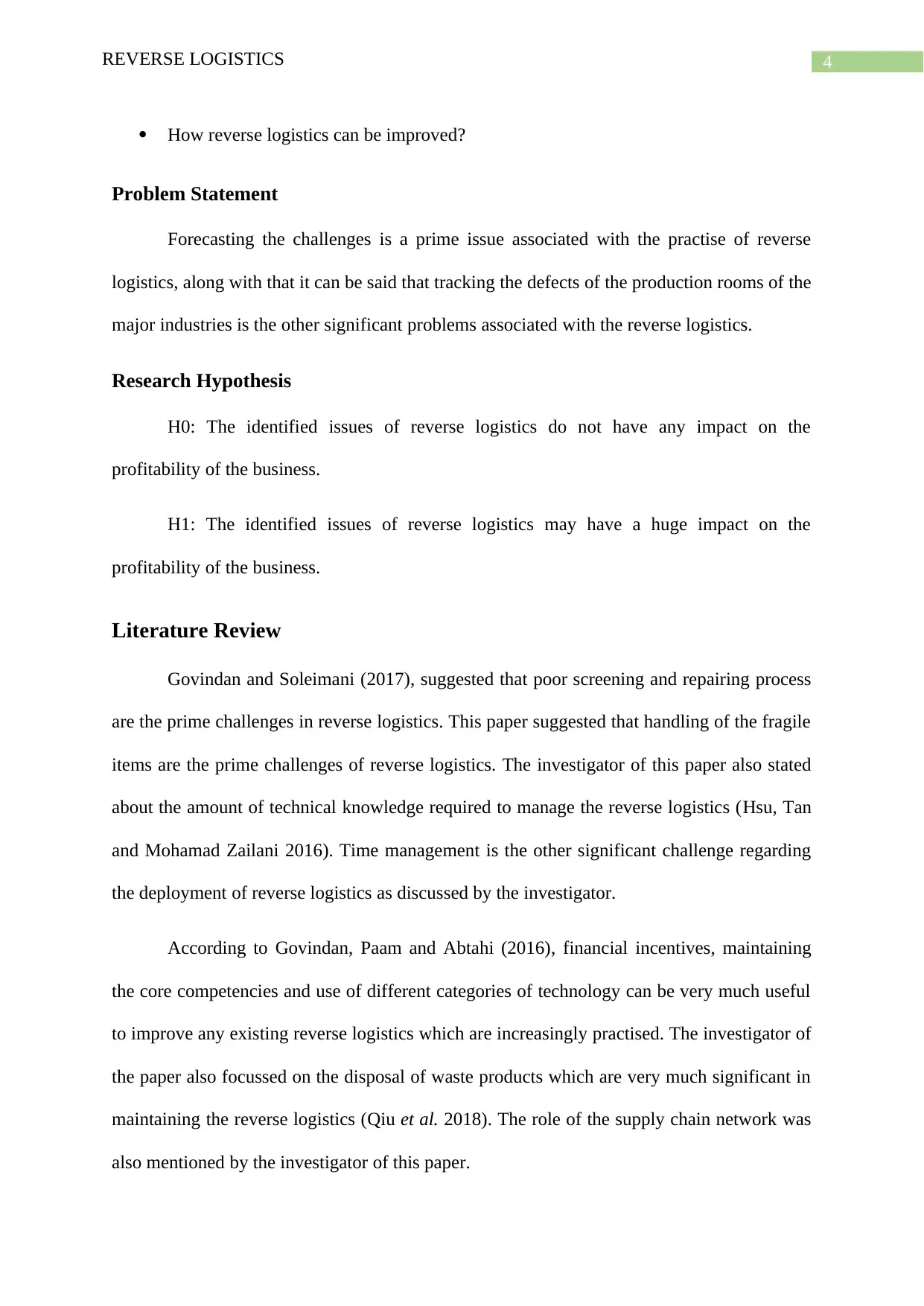
4REVERSE LOGISTICS
How reverse logistics can be improved?
Problem Statement
Forecasting the challenges is a prime issue associated with the practise of reverse
logistics, along with that it can be said that tracking the defects of the production rooms of the
major industries is the other significant problems associated with the reverse logistics.
Research Hypothesis
H0: The identified issues of reverse logistics do not have any impact on the
profitability of the business.
H1: The identified issues of reverse logistics may have a huge impact on the
profitability of the business.
Literature Review
Govindan and Soleimani (2017), suggested that poor screening and repairing process
are the prime challenges in reverse logistics. This paper suggested that handling of the fragile
items are the prime challenges of reverse logistics. The investigator of this paper also stated
about the amount of technical knowledge required to manage the reverse logistics (Hsu, Tan
and Mohamad Zailani 2016). Time management is the other significant challenge regarding
the deployment of reverse logistics as discussed by the investigator.
According to Govindan, Paam and Abtahi (2016), financial incentives, maintaining
the core competencies and use of different categories of technology can be very much useful
to improve any existing reverse logistics which are increasingly practised. The investigator of
the paper also focussed on the disposal of waste products which are very much significant in
maintaining the reverse logistics (Qiu et al. 2018). The role of the supply chain network was
also mentioned by the investigator of this paper.
How reverse logistics can be improved?
Problem Statement
Forecasting the challenges is a prime issue associated with the practise of reverse
logistics, along with that it can be said that tracking the defects of the production rooms of the
major industries is the other significant problems associated with the reverse logistics.
Research Hypothesis
H0: The identified issues of reverse logistics do not have any impact on the
profitability of the business.
H1: The identified issues of reverse logistics may have a huge impact on the
profitability of the business.
Literature Review
Govindan and Soleimani (2017), suggested that poor screening and repairing process
are the prime challenges in reverse logistics. This paper suggested that handling of the fragile
items are the prime challenges of reverse logistics. The investigator of this paper also stated
about the amount of technical knowledge required to manage the reverse logistics (Hsu, Tan
and Mohamad Zailani 2016). Time management is the other significant challenge regarding
the deployment of reverse logistics as discussed by the investigator.
According to Govindan, Paam and Abtahi (2016), financial incentives, maintaining
the core competencies and use of different categories of technology can be very much useful
to improve any existing reverse logistics which are increasingly practised. The investigator of
the paper also focussed on the disposal of waste products which are very much significant in
maintaining the reverse logistics (Qiu et al. 2018). The role of the supply chain network was
also mentioned by the investigator of this paper.
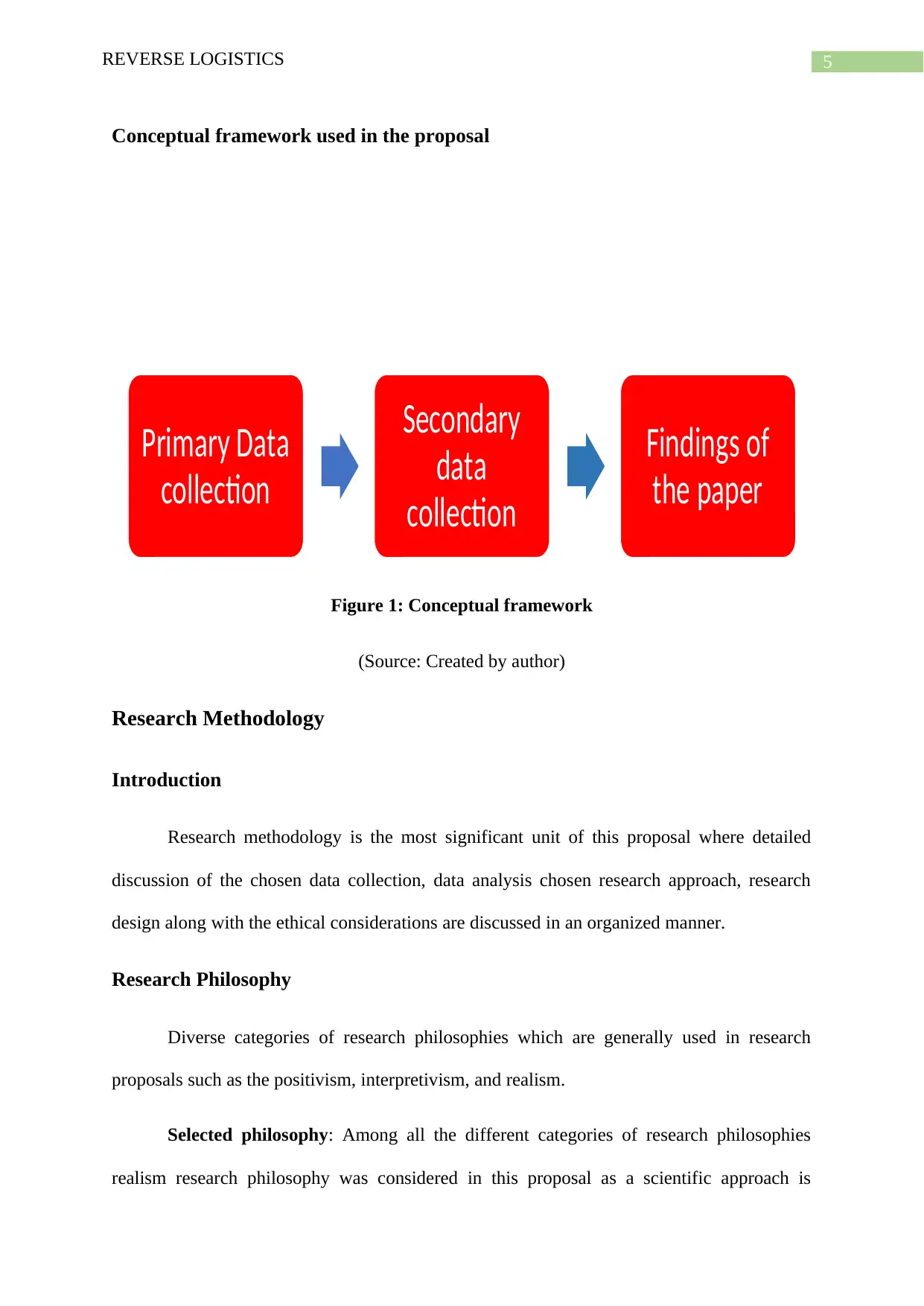
5REVERSE LOGISTICS
Conceptual framework used in the proposal
Figure 1: Conceptual framework
(Source: Created by author)
Research Methodology
Introduction
Research methodology is the most significant unit of this proposal where detailed
discussion of the chosen data collection, data analysis chosen research approach, research
design along with the ethical considerations are discussed in an organized manner.
Research Philosophy
Diverse categories of research philosophies which are generally used in research
proposals such as the positivism, interpretivism, and realism.
Selected philosophy: Among all the different categories of research philosophies
realism research philosophy was considered in this proposal as a scientific approach is
Primary Data
collection
Secondary
data
collection
Findings of
the paper
Conceptual framework used in the proposal
Figure 1: Conceptual framework
(Source: Created by author)
Research Methodology
Introduction
Research methodology is the most significant unit of this proposal where detailed
discussion of the chosen data collection, data analysis chosen research approach, research
design along with the ethical considerations are discussed in an organized manner.
Research Philosophy
Diverse categories of research philosophies which are generally used in research
proposals such as the positivism, interpretivism, and realism.
Selected philosophy: Among all the different categories of research philosophies
realism research philosophy was considered in this proposal as a scientific approach is
Primary Data
collection
Secondary
data
collection
Findings of
the paper
⊘ This is a preview!⊘
Do you want full access?
Subscribe today to unlock all pages.

Trusted by 1+ million students worldwide
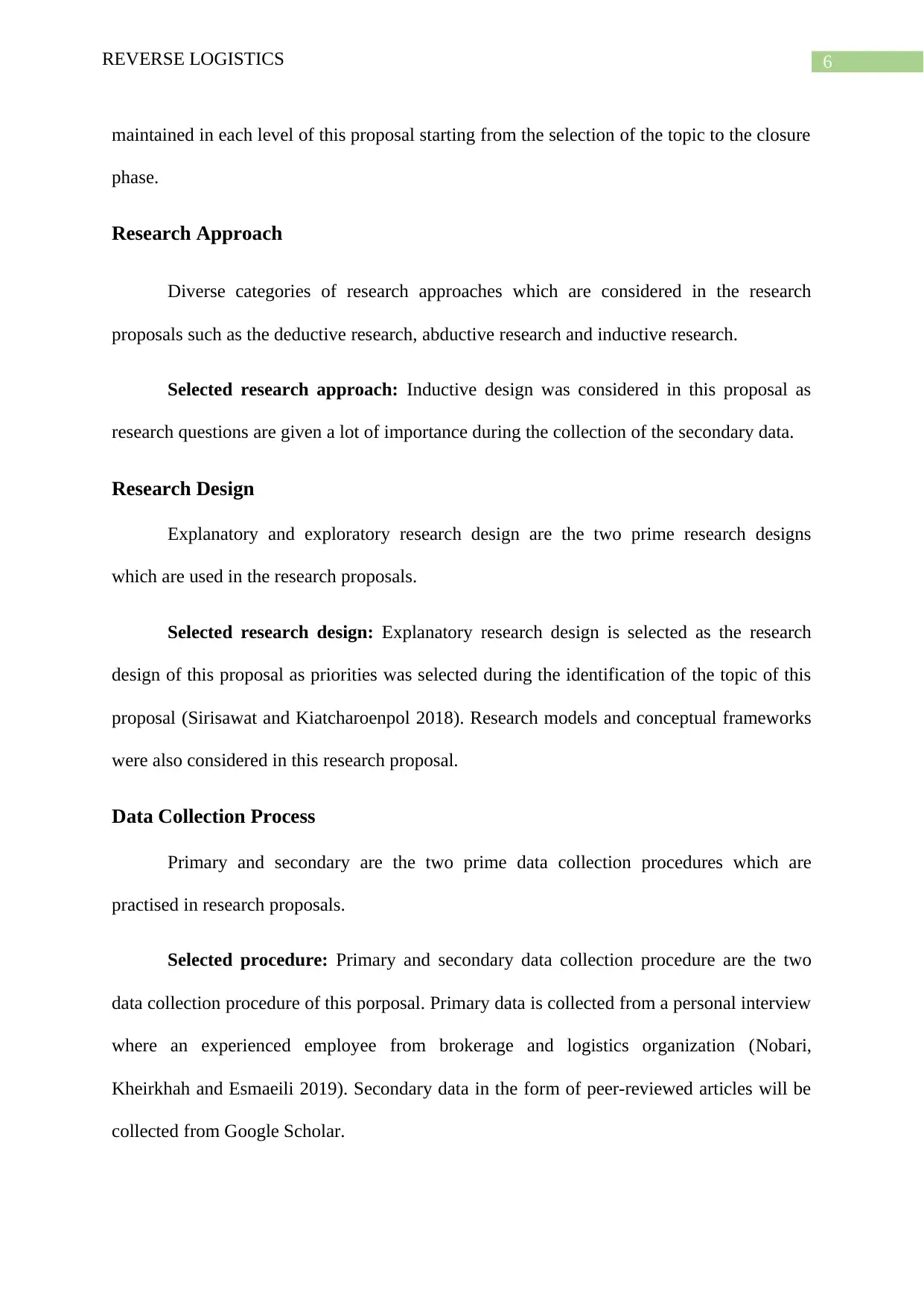
6REVERSE LOGISTICS
maintained in each level of this proposal starting from the selection of the topic to the closure
phase.
Research Approach
Diverse categories of research approaches which are considered in the research
proposals such as the deductive research, abductive research and inductive research.
Selected research approach: Inductive design was considered in this proposal as
research questions are given a lot of importance during the collection of the secondary data.
Research Design
Explanatory and exploratory research design are the two prime research designs
which are used in the research proposals.
Selected research design: Explanatory research design is selected as the research
design of this proposal as priorities was selected during the identification of the topic of this
proposal (Sirisawat and Kiatcharoenpol 2018). Research models and conceptual frameworks
were also considered in this research proposal.
Data Collection Process
Primary and secondary are the two prime data collection procedures which are
practised in research proposals.
Selected procedure: Primary and secondary data collection procedure are the two
data collection procedure of this porposal. Primary data is collected from a personal interview
where an experienced employee from brokerage and logistics organization (Nobari,
Kheirkhah and Esmaeili 2019). Secondary data in the form of peer-reviewed articles will be
collected from Google Scholar.
maintained in each level of this proposal starting from the selection of the topic to the closure
phase.
Research Approach
Diverse categories of research approaches which are considered in the research
proposals such as the deductive research, abductive research and inductive research.
Selected research approach: Inductive design was considered in this proposal as
research questions are given a lot of importance during the collection of the secondary data.
Research Design
Explanatory and exploratory research design are the two prime research designs
which are used in the research proposals.
Selected research design: Explanatory research design is selected as the research
design of this proposal as priorities was selected during the identification of the topic of this
proposal (Sirisawat and Kiatcharoenpol 2018). Research models and conceptual frameworks
were also considered in this research proposal.
Data Collection Process
Primary and secondary are the two prime data collection procedures which are
practised in research proposals.
Selected procedure: Primary and secondary data collection procedure are the two
data collection procedure of this porposal. Primary data is collected from a personal interview
where an experienced employee from brokerage and logistics organization (Nobari,
Kheirkhah and Esmaeili 2019). Secondary data in the form of peer-reviewed articles will be
collected from Google Scholar.
Paraphrase This Document
Need a fresh take? Get an instant paraphrase of this document with our AI Paraphraser
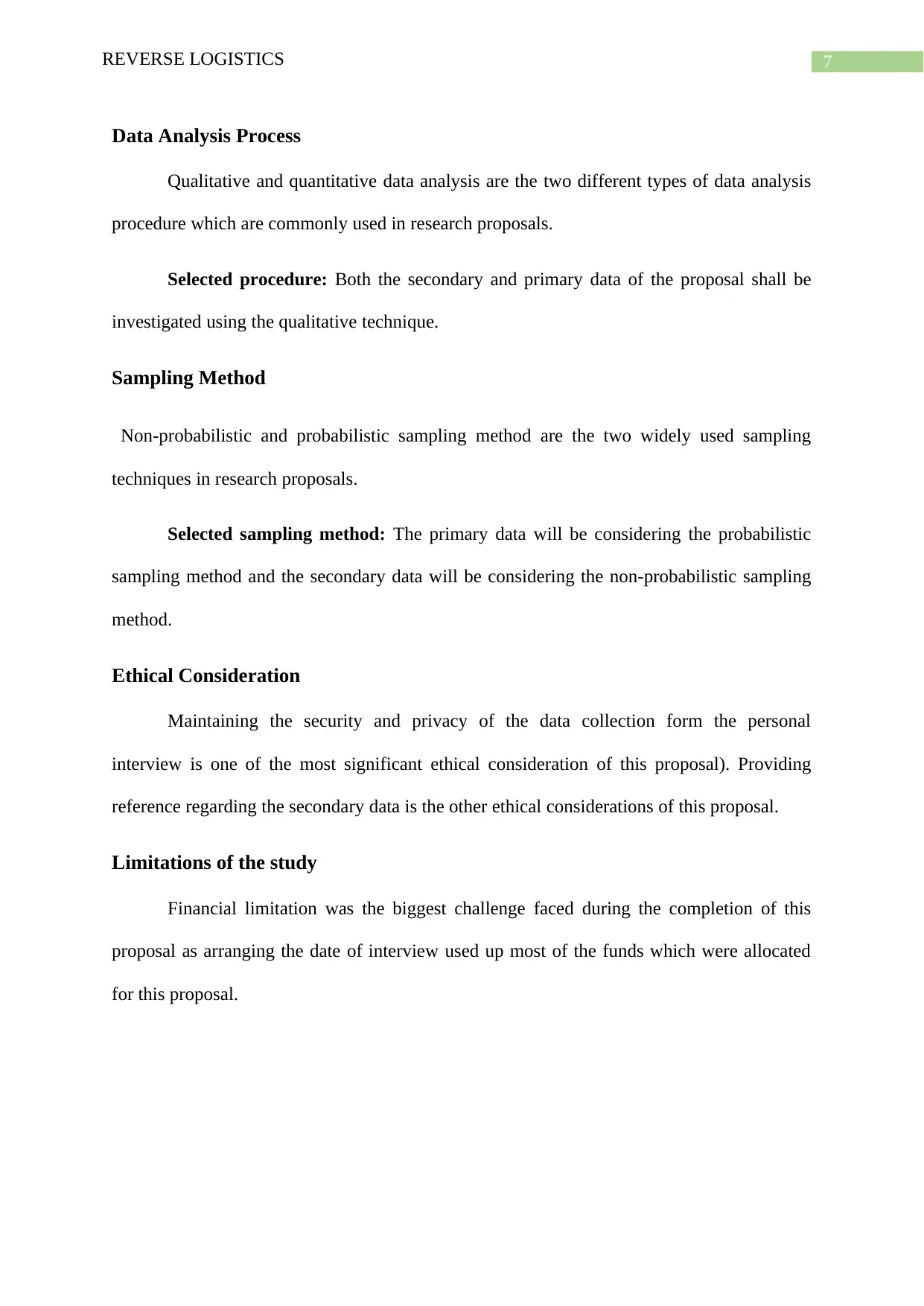
7REVERSE LOGISTICS
Data Analysis Process
Qualitative and quantitative data analysis are the two different types of data analysis
procedure which are commonly used in research proposals.
Selected procedure: Both the secondary and primary data of the proposal shall be
investigated using the qualitative technique.
Sampling Method
Non-probabilistic and probabilistic sampling method are the two widely used sampling
techniques in research proposals.
Selected sampling method: The primary data will be considering the probabilistic
sampling method and the secondary data will be considering the non-probabilistic sampling
method.
Ethical Consideration
Maintaining the security and privacy of the data collection form the personal
interview is one of the most significant ethical consideration of this proposal). Providing
reference regarding the secondary data is the other ethical considerations of this proposal.
Limitations of the study
Financial limitation was the biggest challenge faced during the completion of this
proposal as arranging the date of interview used up most of the funds which were allocated
for this proposal.
Data Analysis Process
Qualitative and quantitative data analysis are the two different types of data analysis
procedure which are commonly used in research proposals.
Selected procedure: Both the secondary and primary data of the proposal shall be
investigated using the qualitative technique.
Sampling Method
Non-probabilistic and probabilistic sampling method are the two widely used sampling
techniques in research proposals.
Selected sampling method: The primary data will be considering the probabilistic
sampling method and the secondary data will be considering the non-probabilistic sampling
method.
Ethical Consideration
Maintaining the security and privacy of the data collection form the personal
interview is one of the most significant ethical consideration of this proposal). Providing
reference regarding the secondary data is the other ethical considerations of this proposal.
Limitations of the study
Financial limitation was the biggest challenge faced during the completion of this
proposal as arranging the date of interview used up most of the funds which were allocated
for this proposal.
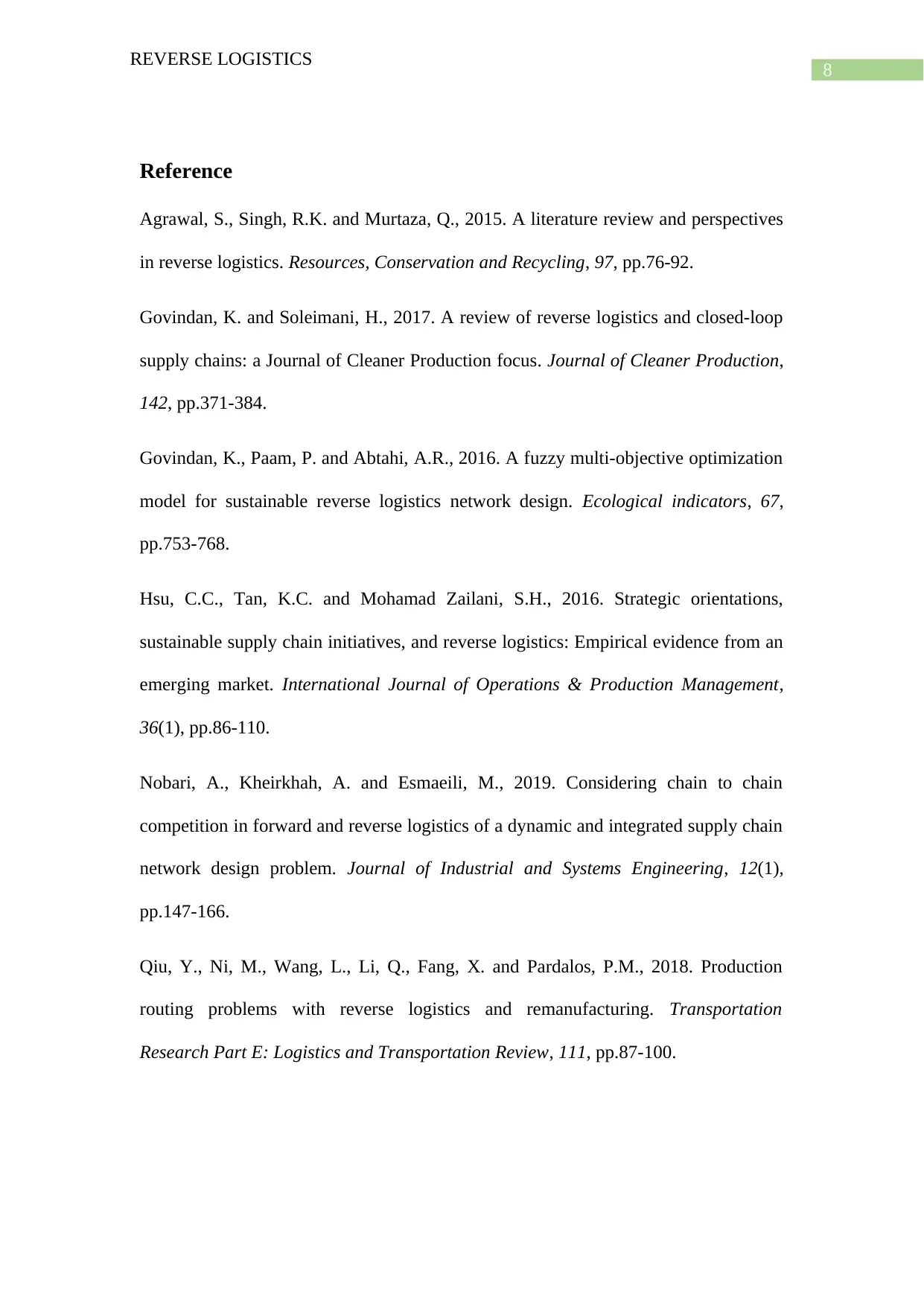
8
REVERSE LOGISTICS
Reference
Agrawal, S., Singh, R.K. and Murtaza, Q., 2015. A literature review and perspectives
in reverse logistics. Resources, Conservation and Recycling, 97, pp.76-92.
Govindan, K. and Soleimani, H., 2017. A review of reverse logistics and closed-loop
supply chains: a Journal of Cleaner Production focus. Journal of Cleaner Production,
142, pp.371-384.
Govindan, K., Paam, P. and Abtahi, A.R., 2016. A fuzzy multi-objective optimization
model for sustainable reverse logistics network design. Ecological indicators, 67,
pp.753-768.
Hsu, C.C., Tan, K.C. and Mohamad Zailani, S.H., 2016. Strategic orientations,
sustainable supply chain initiatives, and reverse logistics: Empirical evidence from an
emerging market. International Journal of Operations & Production Management,
36(1), pp.86-110.
Nobari, A., Kheirkhah, A. and Esmaeili, M., 2019. Considering chain to chain
competition in forward and reverse logistics of a dynamic and integrated supply chain
network design problem. Journal of Industrial and Systems Engineering, 12(1),
pp.147-166.
Qiu, Y., Ni, M., Wang, L., Li, Q., Fang, X. and Pardalos, P.M., 2018. Production
routing problems with reverse logistics and remanufacturing. Transportation
Research Part E: Logistics and Transportation Review, 111, pp.87-100.
REVERSE LOGISTICS
Reference
Agrawal, S., Singh, R.K. and Murtaza, Q., 2015. A literature review and perspectives
in reverse logistics. Resources, Conservation and Recycling, 97, pp.76-92.
Govindan, K. and Soleimani, H., 2017. A review of reverse logistics and closed-loop
supply chains: a Journal of Cleaner Production focus. Journal of Cleaner Production,
142, pp.371-384.
Govindan, K., Paam, P. and Abtahi, A.R., 2016. A fuzzy multi-objective optimization
model for sustainable reverse logistics network design. Ecological indicators, 67,
pp.753-768.
Hsu, C.C., Tan, K.C. and Mohamad Zailani, S.H., 2016. Strategic orientations,
sustainable supply chain initiatives, and reverse logistics: Empirical evidence from an
emerging market. International Journal of Operations & Production Management,
36(1), pp.86-110.
Nobari, A., Kheirkhah, A. and Esmaeili, M., 2019. Considering chain to chain
competition in forward and reverse logistics of a dynamic and integrated supply chain
network design problem. Journal of Industrial and Systems Engineering, 12(1),
pp.147-166.
Qiu, Y., Ni, M., Wang, L., Li, Q., Fang, X. and Pardalos, P.M., 2018. Production
routing problems with reverse logistics and remanufacturing. Transportation
Research Part E: Logistics and Transportation Review, 111, pp.87-100.
⊘ This is a preview!⊘
Do you want full access?
Subscribe today to unlock all pages.

Trusted by 1+ million students worldwide
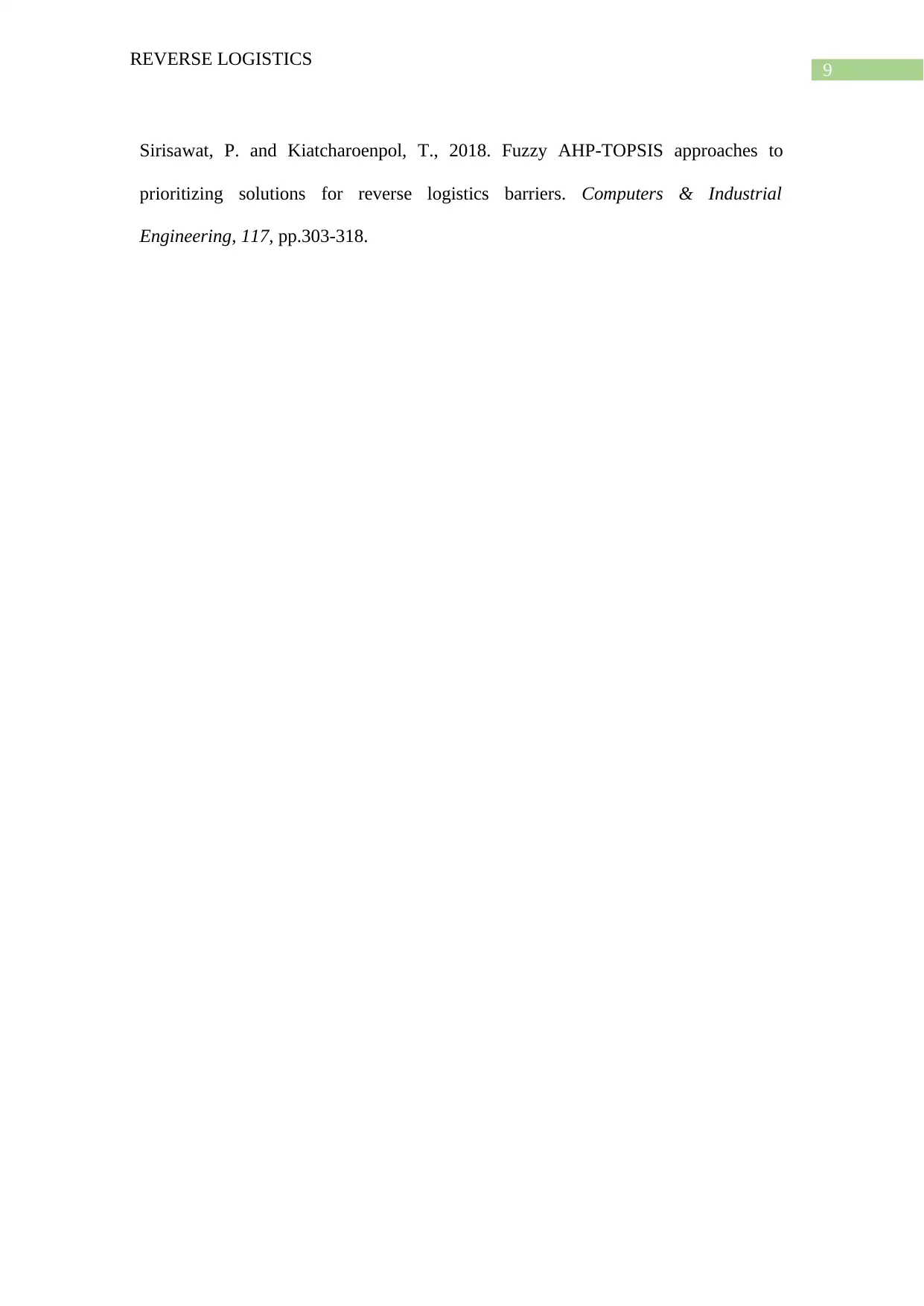
9
REVERSE LOGISTICS
Sirisawat, P. and Kiatcharoenpol, T., 2018. Fuzzy AHP-TOPSIS approaches to
prioritizing solutions for reverse logistics barriers. Computers & Industrial
Engineering, 117, pp.303-318.
REVERSE LOGISTICS
Sirisawat, P. and Kiatcharoenpol, T., 2018. Fuzzy AHP-TOPSIS approaches to
prioritizing solutions for reverse logistics barriers. Computers & Industrial
Engineering, 117, pp.303-318.
1 out of 10
Related Documents
Your All-in-One AI-Powered Toolkit for Academic Success.
+13062052269
info@desklib.com
Available 24*7 on WhatsApp / Email
![[object Object]](/_next/static/media/star-bottom.7253800d.svg)
Unlock your academic potential
Copyright © 2020–2025 A2Z Services. All Rights Reserved. Developed and managed by ZUCOL.





